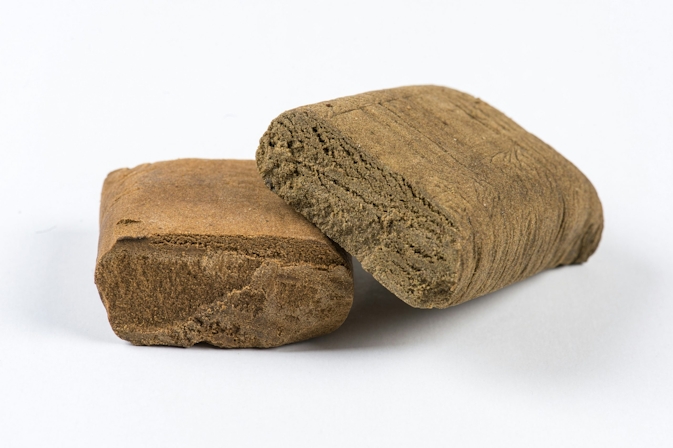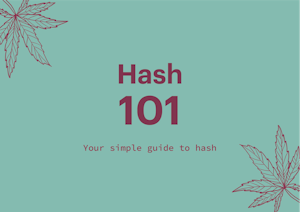
Kief Vs. Hash: What’s The Difference?
Kief and Hash are popular words related to weed. But do you really know what they are and how they differ?
Have you ever found yourself wondering about the differences between kief and hash?
Even experienced consumers may ask themselves this question at some point, and that is because although they are both 4-letter words that relate to weed, many people use them as if they are interchangeable and well, they are not.
Kief is one thing and hash is another. Both are derived from the cannabis plant. However, they differ significantly in their composition, potency, method of consumption, and effect on the consumer.
What Is Kief?

Photo by Wellness Connection
Let’s put some magic on this: Kief is like the fairy dust of the cannabis world. It sounds very romantic, but basically, it is.
The kief are those little crystalline structures in the buds that make them glisten, which are called trichomes, and are the fancy term for the plant’s resin glands.
These trichomes are little factories of cannabinoids and terpenes, the secret sauce behind the effects we love. And guess what? Kief is loaded with these potent compounds, giving you a high that’s pure magic.
Getting kief is as easy as using a three-piece grinder. You grind your buds, and voila, the kief collects at the bottom. And now comes the fun part: you can sprinkle it on your joint or bowl for an extra kick, or get creative and make homemade hash.
Curious about the details? We’ve got a complete guide to kief, from harvesting to making it, so check it out.
What Is Hash?

Photo by Hakuna Matata
Hash, on the other hand, is all about potency and tradition. This time-tested cannabis product has a rich history dating back centuries and has been a staple in many cultures around the world.
Hash is essentially kief subjected to heat and pressure to form a dense, compact mass. This process transforms the raw trichomes into a product that is easier to handle, store and consume.
It is often preferred by experienced consumers for its intense effects. Its longer shelf life, compactness, and ease of transport make it a popular choice among many.
The exact properties and effects of hash can vary greatly depending on the method used to make it and the specific strain of cannabis it comes from. Some forms of hash are soft and pliable, while others are hard and brittle.
Similarly, hash’s potency, flavor, and aroma may vary from batch to batch. But regardless of these variables, hash is generally considered a stronger, more concentrated form of cannabis.
Feeling like a cannabis alchemist? You can even make hash at home. Gather enough kief, sandwich it between waxed paper, and press it well with a hair straightener or iron.
Key Differences Between Kief And Hash
Although kief and hash are both trichome-derived products, they have key differences.
Kief is a loose, powdery substance collected directly from the cannabis plant, while hash is the result of processing and compressing kief into a solid form.
Another significant difference is its potency. Kief is like the high school version of THC – it’s potent, no doubt, but it’s not exactly a heavyweight. Hash, on the other hand, is a college graduate with a Ph.D. in potency. The difference between drinking a latte and an espresso is that both are good, but one is more concentrated.
That’s why hash is often the preferred choice for experienced cannabis users looking for a more intense high. The method of consumption also varies. Kief can be sprinkled on cannabis flowers or pressed into resin. Hash, however, is smoked in small pieces or vaporized.
Now let’s talk about purity. Kief is like a mixture of trichomes containing those precious crystals and some plant matter. Basically, what you see is what you get. Hash, conversely, undergoes a purification process – a little heat, a little pressure – leaving behind the impurities and giving you an elegant, refined product.
Bubble Hash Vs. Kief

The key difference is in the water. For bubble hash, it’s all about H2O.
Mix your trimmings or buds with ice water and shake it up. This separates the trichomes from the plant matter, and you get a mixture of water and trichomes. After a bit of filtering magic through progressively smaller screens to remove any plant material, you are left with bubble hash.
Kief, on the other hand, skips the water park. It’s a dry process; only the grinder does its job. No need for a bathing suit: the trichomes fall directly, without water in between.
The name “bubble hash” comes from how the product bubbles when exposed to heat. It is a unique type of hash made using a water filtration process, so it’s often considered purer and more potent than regular hash and kief.
Kief, on the other hand, is like snow on your windowsill. It’s dry, thin, and can be powdery. There are no bubbles here, just pure, unadulterated trichomes.
How To Consume Hash And Kief
Edibles: You can incorporate both hash and kief into your homemade masterpieces. Decarboxylate your hash or kief (activate those cannabinoids), mix them with fats like oil or butter, and infuse them into your favorite recipes. Brownies, cookies, or even a savory dish: the possibilities are as vast as your culinary imagination.
Pre-rolls: Give your usual joint a special touch by adding a pinch of kief or a layer of finely shredded hash to the mix. The result? A smoking experience that’s a notch above the usual, with an extra kick of potency. Ensure the kief or hash is mixed evenly with the flower for an even burn and maximum enjoyment of the experience.
Pipe: Stay classic with a pipe. For hash, you can heat a small piece until it crumbles and sprinkle it in your pipe. Take a puff, and you’ll be on a concentrated trip. As for the kief, sprinkle it on your flower in the pipe and light the magic. Inhale, exhale, and enjoy the enhanced flavors and effects.
Vape: For a smoother experience, consider vaporizing hash or kief. Many vaporizers are designed to handle concentrates, so it’s an elegant and discreet way to indulge.
Moon rocks: Create your own moon rocks by taking a cannabis bud, coating it with hash oil or concentrate, and rolling it in kief. The result is a potent, multi-layered cannabis experience. For an out-of-this-world adventure, smoke it in a pipe, bong, or vaporizer.
Herb Recommended Products:










